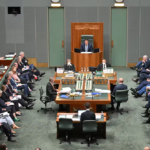The news for journalism in the past decade has been decidedly glum. Whether it be newsroom layoffs, the loss of advertising revenue to Facebook and Google, raids on journalists and media organisations, the spread of fake news, and a swag of security laws that threaten reporters, it seems that the fight to publish verified truth, or at least the best version of it, is being lost.
The peculiar thing, in my view, is that it appears investigative journalism – the highest form of the craft – is actually in a healthy state.
This view runs counter to conventional wisdom – that investigative journalism, and by extension the health of our democracy, is under threat as never before. It’s easy to understand why people would believe this to be true. Investigative journalism takes time and is expensive to produce when compared to an opinion piece or a regular news story.
Furthermore, it can’t be monetised – an investigative project that might take three to five months to produce isn’t made available to the public at any additional cost to a normal digital or newspaper subscription or sale.

There may be positive outcomes for society or inquiries, sackings and so on that flow from an investigative story, and perhaps the media organisation’s reputation for quality journalism will be enhanced, but these rewards come nowhere near recovering the cost of producing the journalism, which normally would include numerous editors, photographers, videographers, data and graphics specialists, and lawyers.
When we consider the massive cuts to newsroom budgets that followed the catastrophic loss of advertising revenue to digital platforms, the assumption would be that editors would ditch their costly investigative teams and focus on cheaper stories. Why produce Porsches when they sell for the same price a cheap Kia?
Despite the apparent business logic of this, many newsrooms retained their investigative teams while cutting editors, photographers, artists and general reporting staff, often to the detriment of basic local and rural news coverage.
The figures tell the story. In Australia, the Media Entertainment and Arts Alliance estimates that about 3000 journalist positions have been lost in the past 10 years. In the United States, about 28,000 newsroom jobs were cut between 2008 and 2018. The same survey found that the number of newspaper newsroom employees dropped by 47 per cent over the same period, from about 71,000 to 38,000.
Investigative reporter numbers are hard to track without a comprehensive study of newsrooms and freelance reporters. But investigative reporters never dominated journalistic staff numbers, occupying a small – though boisterous – section in the open spaces of traditional newsrooms.
For the time being, these journalists and their media organisations continue to produce valuable and useful journalism that helps us peer into otherwise hidden financial deals and scams, criminal and corrupt associations, crooked links in the judicial system, and ineptitude by regulators.
Small teams, big impact
So why have media companies retained their small but impactful investigative journalists?
One media academic told me that when making public comments or giving speeches, editors inevitably talk about the big investigative stories they’ve published, but in reality dedicate only about 5 per cent of newsroom budgets to watchdog journalism. I’m not sure about the budget percentage, but it’s an astute observation, because editors want the kudos, impact and, ultimately, reform that such reporting can initiate.
Investigative journalism is noticed by regulators, politicians, corporations and other elite audiences because it has an impact that demands a response. Those under scrutiny need to be seen to be doing something because of what’s been revealed. It may be calling a royal commission, parliamentary or departmental inquiry, a dismissal or just issuing a statement.
Editors like it when this happens. It leads to follow-up stories, and gives them a sense that the journalism is fulfilling its core mission of keeping powerful institutions and individuals accountable.
This mission is integral to the culture of journalism, and that culture is often ignored or downplayed by economists and communications experts who only consider financial rather than cultural factors when analysing media behaviours. Journalists have power within newsrooms to produce the news to what media academic Michael Schudson says is their own best judgment, even when it’s a significant constraint on commercial motives.

In an era of fake news, celebrity news and once-over-lightly news, and a heavy emphasis by television and tabloid media on crime and sport, editors in serious commercial and publicly-funded media recognise that a reputation for independent verified news can deliver an advantage and influence with both advertisers and civically engaged readers.
The view that investigative reporting has been preserved, and even thrived, finally is gaining some traction with academics such as La Trobe University’s Associate Professor Andrea Carson, and Fordham University’s Dr Beth Knobel, whose recent book, The Watchdog Still Barks, pretty much sums up her research findings.
Former New York Times editor Jill Abramson noted that while the publisher, Arthur Ochs Sulzberger, cut two-thirds of the business staff, “he left untouched his newsroom’s most expensive endeavours, such as foreign and investigative reporting”.
Investigative journalism is noticed by regulators, politicians, corporations and other elite audiences because it has an impact that demands a response.
Misconceptions about the future of journalism and its role in democracy in part are a hangover from the pre-internet days when journalists felt no need to explain their practices, motivations and culture to their audience.
That led to public ignorance about the difference between news and spin, the professional relationship that exists between journalists and their sources, the use of off-the-record backgrounding, and issues around independence, objectivity and ethics. Today, journalists such as Kate McClymont and Louise Milligan are more willing to communicate with their audiences via social media.
A recent study by the Society of Professional Journalists in the United States concluded that identifying bias, being transparent and engaging and teaching audiences about how media and journalists operate and make decisions was the best way to restore trust.
In an attempt to demystify some of the practices, beliefs and challenges faced by investigative journalists, I recently created Democracy’s Watchdogs, a multimedia website that will carry video conversations with current and former Australian investigative journalists.
The intention is that the site ultimately will feature 20 to 30 investigative reporters providing a behind-the-scenes look into journalistic culture and practice.
This article was published by Lens.












